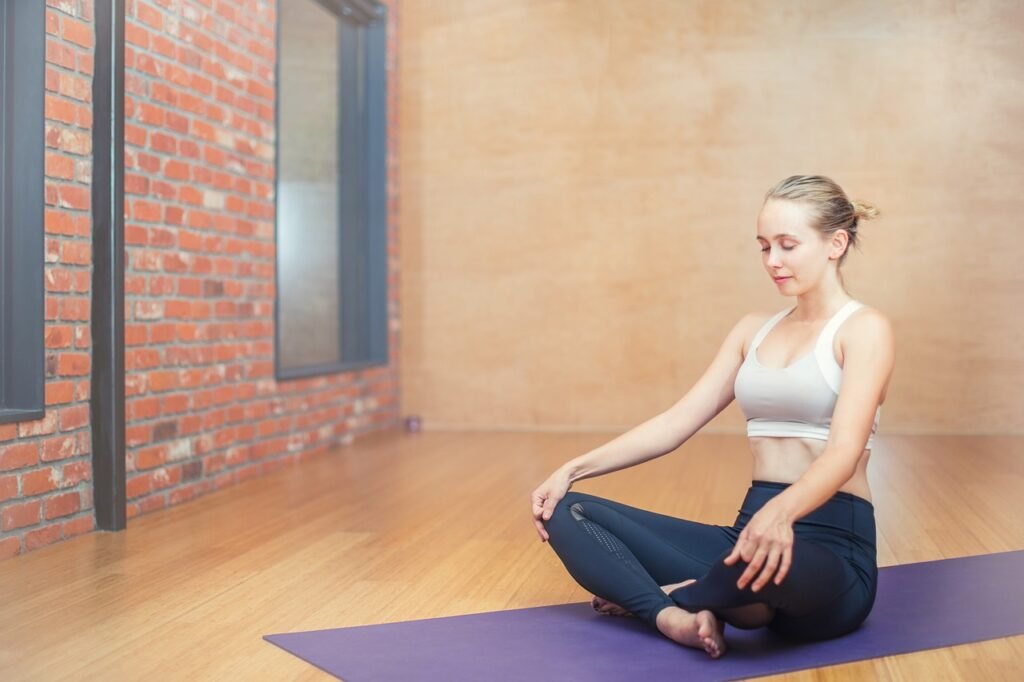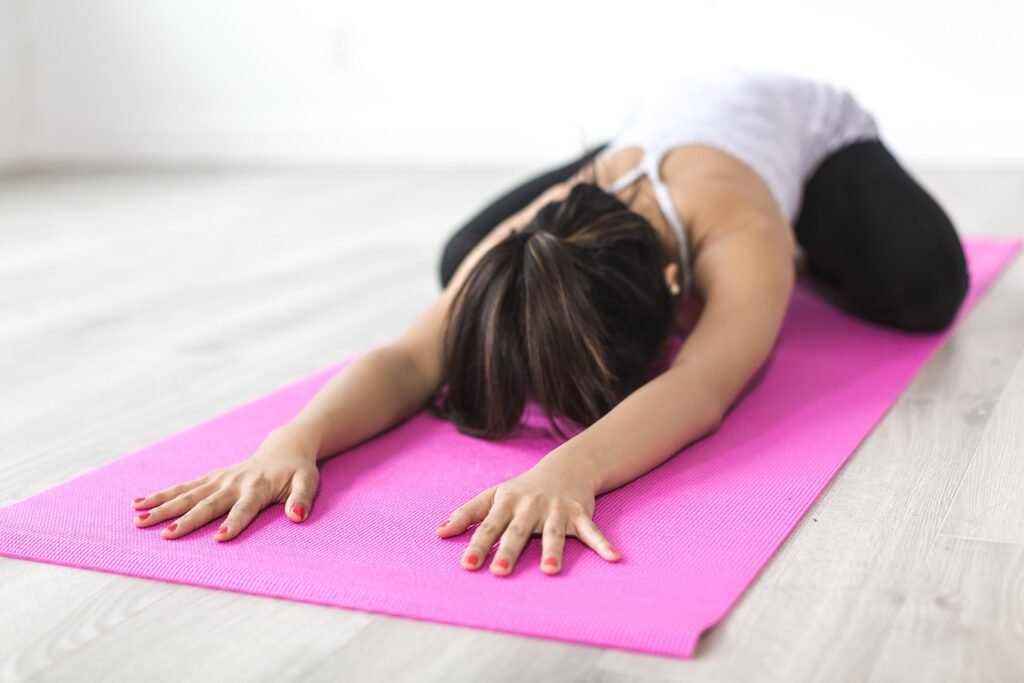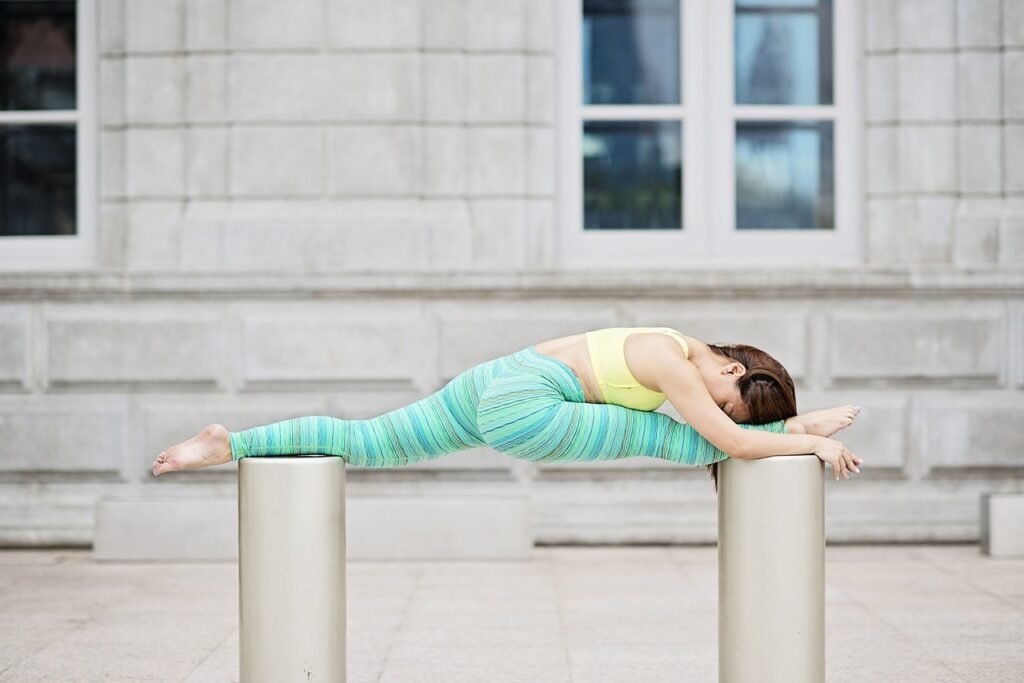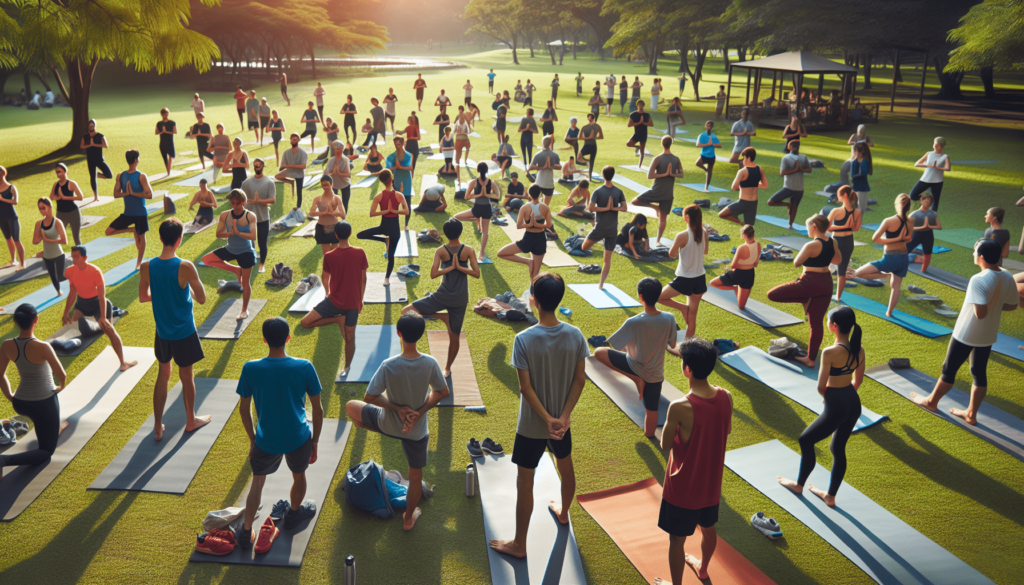If you’re a runner looking to enhance your performance and prevent injuries, incorporating yoga workouts into your routine can be a game-changer. Yoga not only helps you build strength and flexibility, but it also promotes mindfulness and balance – all crucial components for a successful running journey. In this article, we’ll explore some of the best yoga workouts specifically designed to support runners, enabling you to achieve peak performance and find that perfect mind-body connection. So, lace up your shoes and get ready to discover the transformative power of yoga for runners.
Hatha Yoga
Overview
Hatha Yoga is a popular style of yoga that focuses on the physical and mental aspects of the practice. It combines various postures, breathing exercises, and meditation to promote strength, flexibility, and relaxation. Hatha Yoga is suitable for all levels and can be practiced by runners of any experience.
Benefits for Runners
Hatha Yoga offers numerous benefits to runners. Firstly, it helps in building strength by engaging and toning different muscles in the body. This can lead to improved overall performance and reduced risk of injury. Additionally, the focus on breath control and mindfulness in Hatha Yoga can enhance a runner’s mental focus and concentration during their runs.
Furthermore, Hatha Yoga promotes flexibility, which is crucial for runners to maintain a full range of motion in their muscles and joints. By practicing poses that target areas commonly affected by running, such as the hips, hamstrings, and calves, runners can improve their running stride and prevent muscle imbalances.
Another benefit of Hatha Yoga for runners is stress reduction. Running can be physically demanding and mentally exhausting, causing stress to accumulate in the body. Hatha Yoga’s emphasis on deep breathing and relaxation techniques can help runners release tension, improve sleep, and enhance overall well-being.
Recommended Poses
- Mountain Pose (Tadasana): This pose helps improve posture and strengthens the legs, ankles, and core muscles.
- Downward-Facing Dog (Adho Mukha Svanasana): A great pose for strengthening the upper body, stretching the hamstrings and calves, and relieving tension in the spine.
- Warrior II (Virabhadrasana II): This pose targets the hips, thighs, and core muscles, improving balance and stability.
- Triangle Pose (Trikonasana): This posture stretches and strengthens the legs, opens the hips, and improves overall body alignment.
- Pigeon Pose (Eka Pada Rajakapotasana): Ideal for releasing tension in the hips and glutes, this pose improves flexibility and can help prevent IT band issues.
Vinyasa Yoga
Overview
Vinyasa Yoga is a dynamic and flowing style that synchronizes movement with breath. It incorporates a series of poses linked together in a seamless sequence, creating a continuous and energizing flow. Vinyasa Yoga offers a cardiovascular workout combined with strength and flexibility training, making it well-suited for runners.
Benefits for Runners
Vinyasa Yoga provides a full-body workout that complements a runner’s training routine. The continuous movement and flow of Vinyasa Yoga sequences can improve cardiovascular endurance, helping runners build stamina and increase their lung capacity.
Furthermore, the strength-building aspect of Vinyasa Yoga is beneficial for runners. It targets key muscle groups, including the core, arms, and legs, which are essential for maintaining proper form and preventing fatigue during a run. Additionally, the dynamic nature of Vinyasa Yoga poses challenges stability and balance, which can enhance a runner’s overall performance.
In terms of flexibility, Vinyasa Yoga promotes deep stretching and elongation of muscles, which can alleviate muscle tightness and reduce the risk of running-related injuries. The incorporation of various poses, such as forward folds, lunges, and twists, helps stretch the major muscle groups used in running, such as the quadriceps, hamstrings, and hip flexors.
Recommended Poses
- Sun Salutation (Surya Namaskar): A sequence of poses that warms up the entire body, improves flexibility, and builds strength.
- Chair Pose (Utkatasana): This pose strengthens the legs, glutes, and core muscles, improving overall stability and endurance.
- Plank Pose (Kumbhakasana): A great pose for building core strength, strengthening the arms and shoulders, and improving posture.
- Low Lunge (Anjaneyasana): This pose stretches the hip flexors, quadriceps, and hamstrings, helping to alleviate muscle tightness.
- Twisted Triangle (Parivrtta Trikonasana): Ideal for improving spinal mobility, stretching the hamstrings, and strengthening the core.

This image is property of pixabay.com.
Ashtanga Yoga
Overview
Ashtanga Yoga is a vigorous and physically demanding style that follows a specific sequence of poses. It involves synchronized breathing and continuous movement, resulting in a dynamic and challenging practice. Ashtanga Yoga can benefit runners by improving strength, endurance, and mental focus.
Benefits for Runners
One of the main benefits of Ashtanga Yoga for runners is the development of strength. The series of poses in Ashtanga Yoga target various muscle groups, including the arms, core, and legs. By practicing regularly, runners can build the muscular strength required for maintaining proper running form and preventing imbalances.
Furthermore, Ashtanga Yoga promotes endurance through its dynamic and intense nature. The constant movement and flowing sequences require stamina and focus, which can translate into improved performance during long-distance runs. Ashtanga Yoga also emphasizes controlled breathing, which helps runners maintain a steady breath and prevent fatigue.
In addition, Ashtanga Yoga enhances mental focus and concentration. The challenging nature of the practice requires practitioners to be fully present and mindful of their movements and breath. This mental discipline can be beneficial for runners, particularly during races or intense training sessions, helping them stay focused and resilient.
Recommended Poses
- Sun Salutation A and B: These sequences of poses warm up the body, build strength, and improve flexibility.
- Warrior I (Virabhadrasana I): This pose strengthens the legs, opens the hips, and builds stability.
- Boat Pose (Navasana): A pose that engages the core muscles and improves balance, preventing lower back pain.
- Upward-Facing Dog (Urdhva Mukha Svanasana): This pose strengthens the arms, shoulders, and upper back while improving posture.
- Bound Half Moon (Baddha Ardha Chandrasana): Ideal for developing balance, focus, and lower body strength, this pose targets the hips, glutes, and hamstrings.
Yin Yoga
Overview
Yin Yoga is a slow-paced and gentle style that focuses on long-held poses and deep stretching. It targets the connective tissues, such as ligaments and fascia, rather than the muscles, promoting increased flexibility and joint mobility. Yin Yoga can be particularly beneficial for runners who want to enhance their recovery and prevent injuries.
Benefits for Runners
Yin Yoga offers several benefits to runners, especially in terms of recovery and injury prevention. The long-held poses in Yin Yoga help stimulate the deep tissues, allowing for greater flexibility and improved joint range of motion. This can enhance a runner’s overall performance and alleviate discomfort caused by tight muscles or restricted movement.
Additionally, Yin Yoga promotes relaxation and reduces stress. Running can put a significant amount of stress on the body, both physically and mentally. By practicing Yin Yoga, runners can activate the parasympathetic nervous system, known as the “rest and digest” response, which helps reduce cortisol levels and induce a state of deep relaxation.
Another benefit of Yin Yoga for runners is its ability to improve body awareness and mindful movement. By holding poses for an extended period, runners can develop a deeper understanding of their body’s limitations and cues. This increased awareness can prevent overuse injuries and help runners recognize when adjustments or modifications are necessary.
Recommended Poses
- Butterfly Pose (Baddha Konasana): This pose stretches the groin, inner thighs, and lower back, promoting flexibility and relaxation.
- Dragon Pose (Anjaneyasana): A deep hip opener that stretches the quads, hip flexors, and psoas, helping alleviate tightness.
- Seated Forward Fold (Paschimottanasana): This pose targets the hamstrings and lower back, promoting release and lengthening.
- Reclining Bound Angle Pose (Supta Baddha Konasana): Ideal for opening the hips and chest, this pose encourages relaxation and deep breathing.
- Child’s Pose (Balasana): A restorative pose that stretches the lower back, hips, and shoulders, promoting relaxation and releasing tension.

This image is property of pixabay.com.
Restorative Yoga
Overview
Restorative Yoga is a deeply relaxing and therapeutic style that focuses on rest and renewal. It involves the use of props, such as blankets and bolsters, to support the body in gentle, passive poses. Restorative Yoga is suitable for runners of all levels and can help enhance recovery, reduce muscle soreness, and promote overall well-being.
Benefits for Runners
The benefits of Restorative Yoga for runners are centered around recovery and relaxation. After a challenging run or intense training, Restorative Yoga can provide a much-needed opportunity for the body to rest and restore. The use of props in Restorative Yoga allows for long-held and supported poses, which help release tension, reduce muscle soreness, and promote deep relaxation.
Additionally, Restorative Yoga can improve flexibility. The passive nature of the poses allows for a gentle stretch and lengthening of muscles, tendons, and ligaments without putting stress on the body. Regular practice of Restorative Yoga can help runners maintain or improve their flexibility, preventing injuries and improving overall performance.
Furthermore, Restorative Yoga provides a space for runners to reconnect with their breath and quiet the mind. By focusing on deep, diaphragmatic breathing, runners can activate the parasympathetic nervous system and elicit a relaxation response. This can help reduce stress, anxiety, and promote better sleep quality, which are crucial for runners’ recovery and overall well-being.
Recommended Poses
- Supported Legs-Up-The-Wall Pose (Viparita Karani): This pose helps reduce swelling in the legs, relaxes the nervous system, and promotes blood circulation.
- Supported Bridge Pose (Setu Bandha Sarvangasana): A gentle backbend that helps release tension in the lower back, hips, and chest, promoting relaxation.
- Supported Child’s Pose (Balasana): This pose allows for deep relaxation of the neck, shoulders, and back while encouraging steady breathing.
- Reclining Spinal Twist (Jathara Parivartanasana): Ideal for releasing tension in the spine and stretching the hips and lower back, promoting relaxation.
- Corpse Pose (Savasana): The final relaxation pose, Savasana helps release physical and mental tension, promoting overall rejuvenation.
Iyengar Yoga
Overview
Iyengar Yoga is a style that emphasizes precise alignment and the use of props to support the body in poses. It involves holding poses for an extended period, allowing for deepening and refinement. Iyengar Yoga can benefit runners by improving body awareness, correcting imbalances, and reducing the risk of injury.
Benefits for Runners
One of the main benefits of Iyengar Yoga for runners is its focus on alignment and proper form. By practicing Iyengar Yoga, runners can develop a keen sense of body awareness and learn to align their body in a way that supports optimal function and reduces the risk of injury. This attention to alignment can help correct imbalances caused by running, such as tight hips or weak core muscles.
Additionally, Iyengar Yoga provides an opportunity for runners to work on their flexibility. The use of props, such as blocks and straps, allows runners to modify poses and gradually deepen their stretches without straining or overstretching. Improved flexibility can help runners maintain a full range of motion, prevent muscle imbalances, and enhance overall performance.
Furthermore, Iyengar Yoga promotes mental focus and concentration. The precision and attention to detail required in each pose require practitioners to be fully present and engaged. This focused awareness can enhance a runner’s mental resilience, helping them stay focused during runs and races.
Recommended Poses
- Mountain Pose (Tadasana): This foundational pose improves posture, strengthens the legs, and promotes overall body alignment.
- Triangle Pose (Trikonasana): A standing pose that targets the hips, hamstrings, and calves, promoting flexibility and balance.
- Supported Headstand (Salamba Sirsasana): This inversion pose strengthens the core, improves balance, and promotes mental clarity.
- Supported Shoulderstand (Salamba Sarvangasana): An inversion that helps improve circulation, reduce swelling in the legs, and relax the nervous system.
- Seated Forward Fold (Paschimottanasana): This seated pose stretches the hamstrings, lower back, and shoulders, promoting release and relaxation.

This image is property of pixabay.com.
Power Yoga
Overview
Power Yoga is a vigorous and athletic style that combines elements of strength, flexibility, and breath control. It involves dynamic and flowing sequences, often with challenging poses interspersed. Power Yoga is ideal for runners looking to build strength and increase flexibility while maintaining an elevated heart rate.
Benefits for Runners
Power Yoga offers several benefits that can enhance a runner’s performance and overall fitness. Firstly, the dynamic nature of Power Yoga sequences provides a cardiovascular workout, elevating the heart rate and increasing endurance. This can contribute to improved stamina during runs and races.
Additionally, Power Yoga helps build muscular strength and tone. The combination of standing poses, arm balances, and core work in Power Yoga targets major muscle groups, such as the legs, glutes, arms, and core. Strengthening these muscles is essential for maintaining proper running form, preventing injuries, and improving overall performance.
Furthermore, Power Yoga promotes flexibility and mobility. The continuous movement and flow in Power Yoga sequences challenge the muscles and encourage deep stretching, particularly in areas commonly affected by running, such as the hips, hamstrings, and calves. Improved flexibility can enhance a runner’s stride length, range of motion, and prevent muscle imbalances.
Recommended Poses
- Sun Salutation (Surya Namaskar): A dynamic sequence of poses that warms up the entire body, builds strength, and increases flexibility.
- Warrior III (Virabhadrasana III): This standing balance pose strengthens the legs, hips, and core muscles, improving overall stability.
- Crow Pose (Bakasana): An arm balance that strengthens the arms, wrists, and core, enhancing upper body strength and balance.
- Dolphin Pose (Ardha Pincha Mayurasana): This pose prepares the shoulders and core for inversions, building upper body strength and stability.
- Wide-Legged Forward Fold (Prasarita Padottanasana): A pose that stretches the hamstrings, calves, and upper back, promoting flexibility and release.
Bikram Yoga
Overview
Bikram Yoga, also known as hot yoga, is a style practiced in a heated room, usually around 105°F (40°C). It involves a specific sequence of 26 poses and two breathing exercises. Bikram Yoga is well-suited for runners looking for a challenging and intense practice that promotes cardiovascular endurance, flexibility, and mental focus.
Benefits for Runners
Bikram Yoga offers various benefits that can complement a runner’s training and contribute to improved performance. Firstly, the heat in a Bikram Yoga class promotes increased blood flow to the muscles, allowing for deeper stretching and enhanced flexibility. This can help runners maintain a full range of motion, prevent stiffness, and reduce the risk of injury.
Additionally, Bikram Yoga is a cardiovascular workout that elevates the heart rate and improves stamina. The heat and humidity in the room intensify the physical demands of the practice, resulting in increased calorie burn and cardiovascular endurance. This can translate into improved endurance during runs and races.
Furthermore, Bikram Yoga promotes mental focus and concentration. The heat and challenging nature of the practice require practitioners to stay present and focused on their breath and body movements. This increased mental resilience can be beneficial for runners, helping them stay focused during challenging training sessions or races.
Recommended Poses
- Standing Deep Breathing (Pranayama): A breathing exercise that helps calm the mind, increase lung capacity, and prepare for the practice.
- Eagle Pose (Garudasana): This pose improves balance, opens the shoulders, and stretches the calves and hamstrings.
- Triangle Pose (Trikonasana): A standing pose that targets the hips, hamstrings, and calves, promoting flexibility and balance.
- Locust Pose (Salabhasana): This backbend strengthens the lower back, glutes, and hamstrings, improving posture and core stability.
- Camel Pose (Ustrasana): A heart-opening pose that stretches the front body and strengthens the back, promoting flexibility and energizing the body.

Kundalini Yoga
Overview
Kundalini Yoga is a style that emphasizes the awakening of the energy within the body, known as Kundalini. It combines dynamic movements, breathwork, chanting, and meditation to achieve a heightened state of awareness and vitality. Kundalini Yoga can benefit runners by improving energy levels, mental clarity, and overall well-being.
Benefits for Runners
Kundalini Yoga offers several benefits that can enhance a runner’s physical and mental well-being. Firstly, the dynamic movements and controlled breathing in Kundalini Yoga stimulate the body’s energy flow, increasing vitality and reducing fatigue. This can result in improved energy levels during runs and enhanced recovery afterward.
Additionally, Kundalini Yoga promotes mental clarity and focus. The combination of breathwork, meditation, and mantra chanting helps calm the mind, reduce stress, and improve concentration. This mental discipline can be invaluable for runners, helping them stay focused during training and races.
Furthermore, Kundalini Yoga enhances overall well-being and emotional balance. The practice addresses the energetic and emotional aspects of the self, promoting a sense of inner peace, stress reduction, and self-awareness. By incorporating Kundalini Yoga into their routine, runners can enhance their overall mental and emotional resilience.
Recommended Poses
- Breath of Fire (Agni Pran): A powerful breathing technique that invigorates the body, increases lung capacity, and promotes mental clarity.
- Spinal Flexes (Cat-Cow): This gentle warm-up exercise stretches and energizes the spine, improving flexibility and vitality.
- Sat Kriya: A comprehensive exercise that stimulates the entire body, balances the nervous system, and promotes hormone regulation.
- Meditation with Mantra: Practicing meditation with a specific mantra, such as “Sat Nam,” promotes mental focus and clarity.
- Corpse Pose (Savasana): The final relaxation pose allows for deep integration and assimilation of the practice, promoting overall relaxation and rejuvenation.
Yoga for Stretching and Flexibility
Overview
Yoga for Stretching and Flexibility is not tied to a specific yoga style but refers to a collection of poses and practices that promote increased flexibility and range of motion. These poses can be incorporated into any yoga practice or done as a standalone routine. Yoga for Stretching and Flexibility is highly beneficial for runners, as it targets tight muscles and helps prevent injuries.
Benefits for Runners
Yoga for Stretching and Flexibility offers numerous benefits that can enhance a runner’s overall performance and prevent muscle imbalances. Firstly, regular stretching through yoga can promote increased flexibility, allowing runners to maintain a full range of motion, particularly in the hips, hamstrings, and calves. This can lead to improved running form and reduce the risk of injury.
Additionally, incorporating yoga poses for stretching into a runner’s routine can help alleviate muscle soreness and promote faster recovery. The gentle stretches and deep breathing in these poses encourage relaxation and release of muscle tension, aiding in the repair and regeneration of muscles after a run or intense training session.
Furthermore, Yoga for Stretching and Flexibility promotes balance in the body. Running primarily engages specific muscle groups, which can lead to imbalances and compensations. By practicing poses that target both the major muscle groups and the supporting muscles, runners can correct imbalances, enhance stability, and reduce the risk of overuse injuries.
Recommended Poses
- Seated Forward Fold (Paschimottanasana): A seated pose that stretches the hamstrings, calves, and lower back, promoting flexibility and release.
- Reclining Hand-to-Big-Toe Pose (Supta Padangusthasana): This pose targets the hamstrings and hips, improving flexibility and releasing tension.
- Lizard Pose (Utthan Pristhasana): A deep hip opener that stretches the psoas, hips, and groin, improving range of motion.
- Supine Pigeon Pose (Supta Kapotasana): This reclining variation of Pigeon Pose alleviates tightness in the hips and glutes, promoting relaxation and flexibility.
- Standing Forward Fold (Uttanasana): This pose stretches the hamstrings, calves, and spine while promoting a relaxed and mindful state.
In conclusion, incorporating yoga into a runner’s training routine can provide a wide range of benefits. Each style of yoga offers unique advantages, from improvements in strength and endurance to increased flexibility and mental clarity. By exploring the various yoga styles and practicing the recommended poses, runners can enhance their overall fitness, prevent injuries, and enjoy a more balanced and fulfilling running experience. So take a deep breath, roll out your yoga mat, and embrace the transformative power of yoga in your running journey. Namaste!


